THE CHEMISTRY
OF AUTUMN
COLORS
Every autumn across the Northern Hemisphere, diminishing
daylight hours and falling temperatures induce trees to prepare for winter.
In these preparations, they shed billions of tons of leaves. In certain
regions, such as our own, the shedding of leaves is preceded by a spectacular
color show. Formerly green leaves turn to brilliant shades of yellow,
orange, and red. These color changes are the result of transformations
in leaf pigments.
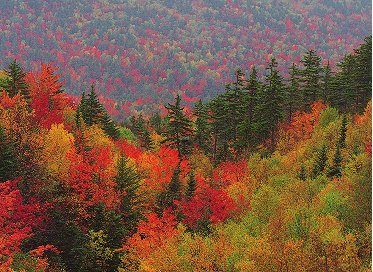
The green pigment in leaves is chlorophyll. Chlorophyll
absorbs red and blue light from the sunlight that falls on leaves. Therefore,
the light reflected by the leaves is diminished in red and blue and appears
green. The molecules of chlorophyll are large (C55H70MgN4O6).
They are not soluble in the aqueous solution that fills plant cells. Instead,
they are attached to the membranes of disc-like structures, called chloroplasts,
inside the cells. Chloroplasts are the site of photosynthesis, the process
in which light energy is converted to chemical energy. In chloroplasts,
the light absorbed by chlorophyll supplies the energy used by plants to
transform carbon dioxide and water into oxygen and carbohydrates, which
have a general formula of
| x CO2 + y H2O | light |
x O2 + Cx(H2O)y |
chlorophyll |
In this endothermic transformation, the energy of the light absorbed by chlorophyll is converted into chemical energy stored in carbohydrates (sugars and starches). This chemical energy drives the biochemical reactions that cause plants to grow, flower, and produce seed.
Chlorophyll is not a very stable compound; bright sunlight causes it to decompose. To maintain the amount of chlorophyll in their leaves, plants continuously synthesize it. The synthesis of chlorophyll in plants requires sunlight and warm temperatures. Therefore, during summer chlorophyll is continuously broken down and regenerated in the leaves of trees.
 |
| Paper birch |
Another pigment found in the leaves of many plants is carotene. Carotene absorbs blue-green and blue light. The light reflected from carotene appears yellow. Carotene is also a large molecule (C40H36) contained in the chloroplasts of many plants. When carotene and chlorophyll occur in the same leaf, together they remove red, blue-green, and blue light from sunlight that falls on the leaf. The light reflected by the leaf appears green. Carotene functions as an accessory absorber. The energy of the light absorbed by carotene is transferred to chlorophyll, which uses the energy in photosynthesis. Carotene is a much more stable compound than chlorophyll. Carotene persists in leaves even when chlorophyll has disappeared. When chlorophyll disappears from a leaf, the remaining carotene causes the leaf to appear yellow.
A third pigment, or class of pigments, that occur in leaves are the anthocyanins. Anthocyanins absorb blue, blue-green, and green light. Therefore, the light reflected by leaves containing anthocyanins appears red. Unlike chlorophyll and carotene, anthocyanins are not attached to cell membranes, but are dissolved in the cell sap. The color produced by these pigments is sensitive to the pH of the cell sap. If the sap is quite acidic, the pigments impart a bright red color; if the sap is less acidic, its color is more purple. Anthocyanin pigments are responsible for the red skin of ripe apples and the purple of ripe grapes. Anthocyanins are formed by a reaction between sugars and certain proteins in cell sap. This reaction does not occur until the concentration of sugar in the sap is quite high. The reaction also requires light. This is why apples often appear red on one side and green on the other; the red side was in the sun and the green side was in shade.
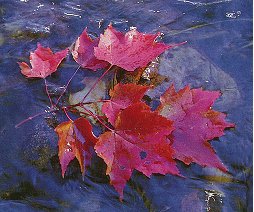 |
| Red Maple |
During summer, the leaves of trees are factories producing sugar from carbon dioxide and water by the action of light on chlorophyll. Chlorophyll causes the leaves to appear green. (The leaves of some trees, such as birches and cottonwoods, also contain carotene; these leaves appear brighter green, because carotene absorbs blue-green light.) Water and nutrients flow from the roots, through the branches, and into the leaves. The sugars produced by photosynthesis flow from the leaves to other parts of the tree, where some of the chemical energy is used for growth and some is stored. The shortening days and cool nights of autumn trigger changes in the tree. One of these changes is the growth of a corky membrane between the branch and the leaf stem. This membrane interferes with the flow of nutrients into the leaf. Because the nutrient flow is interrupted, the production of chlorophyll in the leaf declines, and the green color of the leaf fades. If the leaf contains carotene, as do the leaves of birch and hickory, it will change from green to bright yellow as the chlorophyll disappears. In some trees, as the concentration of sugar in the leaf increases, the sugar reacts to form anthocyanins. These pigments cause the yellowing leaves to turn red. Red maples, red oaks, and sumac produce anthocyanins in abundance and display the brightest reds and purples in the autumn landscape.
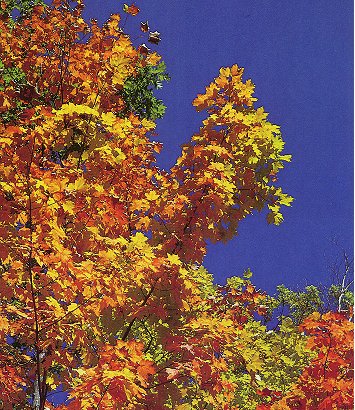 |
| Sugar Maple |
The range and intensity of autumn colors is greatly influenced by the weather. Low temperatures destroy chlorophyll, and if they stay above freezing, promote the formation of anthocyanins. Bright sunshine also destroys chlorophyll and enhances anthocyanin production. Dry weather, by increasing sugar concentration in sap, also increases the amount of anthocyanin. So the brightest autumn colors are produced when dry, sunny days are followed by cool, dry nights.
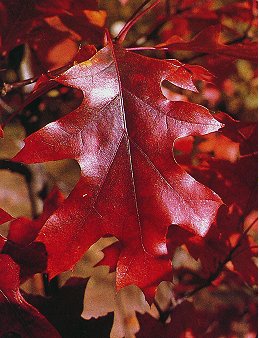 |
| Red Oak |
In recent years, autumn colors have been attracting more and more tourists and travelers to prime color regions: New England, Michigan, and Wisconsin. (In Wisconsin, the fall-color tourists spend over $1 billion.) The right combination of tree species and likely weather conditions produce the most spectacular displays in these regions. States in these regions maintain a fall foliage "hotline," keeping color watchers apprised of the peak viewing locations and times. In Wisconsin, this information is provided by the Division of Tourism at (800) 432-8747 and on the Web at www.travelwisconsin.com/search/FallColorReport.html. The U.S. Forest Service also operates a Fall Foliage Hotline at (800) 354-4595. A detailed report can be found on the Web at www.fs.fed.us/news/fallcolors/.
.
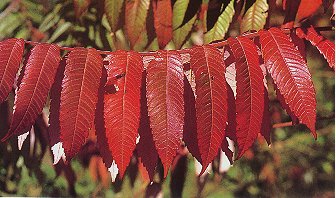 |
| Sumac |
Read a PBS article on fall colors citing Prof. Shakhashiri HERE.